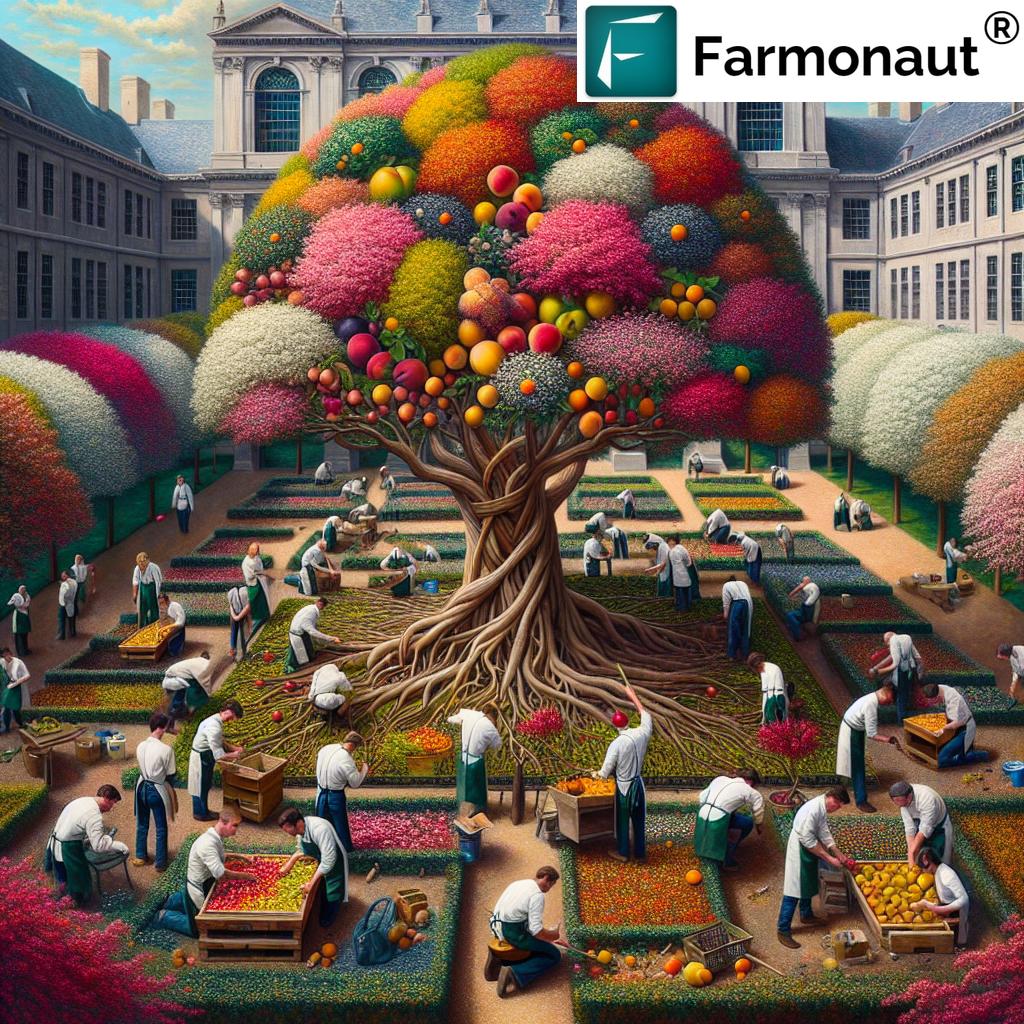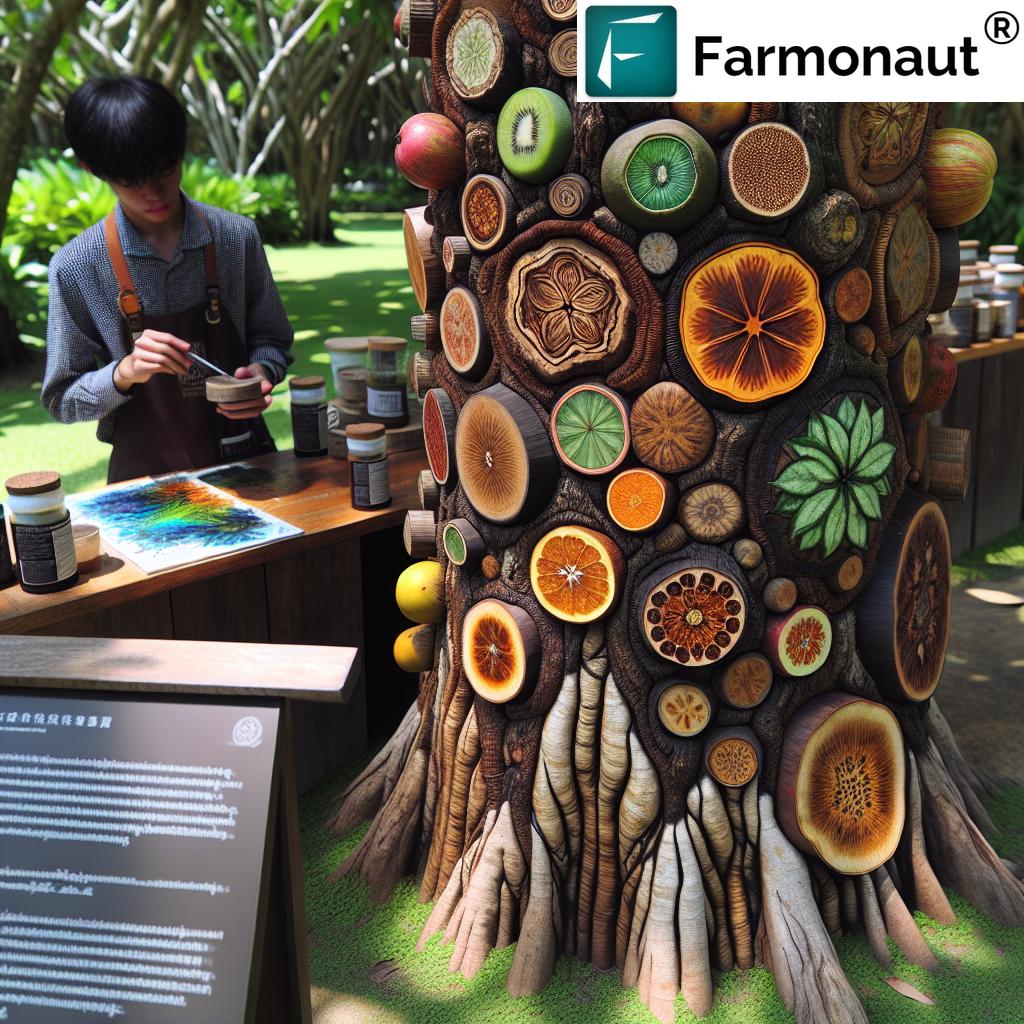Grafting Innovation: Philadelphia’s Living Art Installation Blends Horticulture and History
“The ‘Tree of 40 Fruit’ can produce 40 different types of stone fruits on a single tree.”
In the heart of Philadelphia, a remarkable fusion of art, science, and nature has taken root on the main campus of Temple University. We are witnessing the birth of a living art installation that not only captivates the eye but also serves as a testament to horticultural innovation and historical preservation. This extraordinary creation, known as the “Tree of 40 Fruit,” is the brainchild of contemporary artist Sam Van Aken, and it’s revolutionizing the way we think about agriculture, art, and education.
As we delve into this fascinating project, we’ll explore the ancient technique of grafting, the rich history of fruit cultivation, and the profound impact this living sculpture is having on students and the community. Join us on a journey through time and nature as we uncover the secrets of this botanical marvel and its significance in our modern world.
The Birth of a Botanical Wonder
Imagine a single tree capable of producing 40 different types of stone fruits. It sounds like something out of a fairy tale, doesn’t it? Yet, this is precisely what Van Aken has achieved with his “Tree of 40 Fruit.” This living art installation is a testament to the possibilities that arise when we blend creativity with scientific knowledge.

The tree, now gracing Temple University’s campus, is engineered to grow a variety of stone fruits, including apricots, cherries, peaches, and plums, all from a single trunk. This diversity not only creates a visually stunning display but also serves as a living gene bank, preserving rare and heirloom varieties that might otherwise be lost to time.
The Ancient Art of Grafting
“Grafting, the technique used to create this living art installation, dates back to 1800 B.C., over 3,800 years ago.”
At the heart of this horticultural marvel lies the ancient technique of grafting. Van Aken utilizes this method, which dates back to around 1800 B.C., to create his extraordinary trees. But what exactly is grafting, and why is it so crucial in horticulture?
Grafting is a horticultural technique that involves joining parts from two or more plants so they grow together as a single plant. In the case of the Tree of 40 Fruit, Van Aken combines the scion (the upper part of a tree with desirable fruit characteristics) with the rootstock of a stronger, more resilient species.
According to the University of Hampshire Extension, grafting is crucial for several reasons:
- It allows for the propagation of plants that don’t reproduce true to seed
- It can create plants with specific desired characteristics
- It enables the repair of damaged trees
- It can accelerate the maturity of seedlings
This ancient technique is not just a tool for agricultural production; it’s a bridge between past and present, allowing us to preserve and propagate heirloom varieties that might otherwise be lost to time.
A Living Museum of Fruit History
Van Aken’s Tree of 40 Fruit is more than just an artistic or agricultural endeavor; it’s a living museum, preserving the rich history of fruit cultivation. Each branch tells a story of human civilization, migration, and adaptation.
“For me, what became very interesting in this discovery process was that these heirloom fruits were not just agricultural products,” Van Aken explains. “They are cultural objects. They contain not only nutritional or gustatory value but also the history of world civilization.”
This perspective transforms the tree into a time capsule, each fruit variety a chapter in the story of human agriculture. From ancient wild plums to modern hybrids like pluots, the tree encapsulates millennia of horticultural history.
Hands-On Learning: Grafting Workshops and Beyond
The presence of the Tree of 40 Fruit on Temple University’s campus has opened up exciting educational opportunities. Students now have the chance to study the horticultural techniques employed in the tree’s creation and explore the fascinating intersection of art and nature.
During workshops, students get hands-on experience grafting their own fruit tree branches. This practical approach allows them to understand the delicate process of creating new life from small pieces, bridging the gap between theory and practice.
Sasha Eisenman, Professor of Horticulture and Chair of the Department of Architecture and Environmental Design, emphasizes the value of this interdisciplinary approach: “Bringing artists who work through trees to campus is an extraordinary opportunity. Seeing how art, science, and nature connect to each other is very valuable for students.”
Beyond Grafting: Botanical Cyanotypes
Van Aken’s contribution to education extends beyond grafting. He also conducted a workshop on botanical cyanotypes, a UV-based photography technique for creating blueprints from plants. This innovative approach allows students to create artwork using natural light on paper and cloth, further blending scientific principles with artistic expression.
Jami Deluca, a student participant, shared her admiration: “Seeing firsthand the process carried out by people who are very skilled in cyanotypes is truly extraordinary. Sam is like a detective – finding a rare plant, examining its history, and preserving it through art.”
This multifaceted approach to learning not only enhances students’ understanding of horticulture and art but also fosters creativity and critical thinking skills that are valuable across disciplines.
The Long Journey of Creation
Creating a Tree of 40 Fruit is no small feat. It’s a labor of love that requires patience, skill, and an deep understanding of plant biology. “It takes up to eight years to create one tree,” Van Aken explains. “Every grafted variety has a slightly different shape and color.”
The process is meticulous and time-consuming:
- It typically takes a year to determine if a graft is successful.
- It takes two to three years for the tree to bear fruit.
- The full realization of all 40 varieties can take up to eight years.
This long-term commitment reflects the patience required in both art and agriculture, reminding us of the slow, steady rhythms of nature.

Preserving Biodiversity and Cultural Heritage
The Tree of 40 Fruit is more than just a beautiful oddity; it’s a crucial tool in preserving biodiversity and cultural heritage. By grafting rare and heirloom varieties onto a single tree, Van Aken is creating living arboretums that safeguard genetic diversity in fruit trees.
This preservation is especially important in the face of climate change and the industrialization of agriculture, which often favors a few commercially viable varieties over the rich tapestry of heirloom fruits. Each Tree of 40 Fruit serves as a genetic repository, ensuring that these unique varieties – and the cultural stories they carry – are not lost to time.
The Intersection of Art and Agriculture
The Tree of 40 Fruit project beautifully illustrates the potential for collaboration between art and agriculture. It challenges our perceptions of what constitutes art and what defines agriculture, blurring the lines between these traditionally separate domains.
This intersection opens up new possibilities for innovation in both fields. For artists, it presents new mediums and concepts to explore. For agriculturists, it offers fresh perspectives on crop development and preservation. The project serves as a reminder that creativity and scientific knowledge can work hand in hand to produce something truly extraordinary.
Environmental Awareness and Sustainability
The Tree of 40 Fruit project also serves as a powerful tool for raising environmental awareness and promoting sustainability. By showcasing the diversity of fruit varieties that can be grown in a single tree, it highlights the importance of biodiversity in our ecosystems.
This living art installation encourages viewers to think about the food they consume, where it comes from, and the impact of agricultural practices on the environment. It serves as a starting point for discussions about sustainable farming, genetic diversity, and the preservation of heirloom varieties.
For those interested in monitoring and reducing environmental impact in agriculture, tools like Farmonaut’s carbon footprinting solution can provide valuable insights. This technology allows farmers and agribusinesses to track their carbon emissions in real-time, supporting more sustainable farming practices.
The Future of Urban Agriculture
The presence of the Tree of 40 Fruit on a university campus in Philadelphia points to exciting possibilities for urban agriculture. It demonstrates that even in city environments, we can create spaces that are both beautiful and productive, contributing to local food systems while educating the public about agriculture and biodiversity.
This project could inspire similar initiatives in other urban areas, transforming city landscapes into productive orchards that provide fresh, local produce while serving as living educational tools. It’s a vision of future cities where nature and urban development coexist harmoniously, creating more sustainable and resilient communities.
For those interested in large-scale agricultural management, whether in urban or rural settings, Farmonaut’s large scale farm management solutions offer advanced tools for optimizing operations and improving productivity.
Educational Impact Beyond the Campus
While the immediate impact of the Tree of 40 Fruit is felt on Temple University’s campus, its educational value extends far beyond. The project has garnered national and international attention, sparking conversations about biodiversity, agricultural history, and the role of art in science education.
Van Aken’s work serves as a model for interdisciplinary education, demonstrating how art can be used to teach complex scientific concepts and historical narratives. It encourages educators in various fields to think creatively about how they can incorporate hands-on, multidisciplinary approaches in their teaching.
The Economic Potential of Innovative Agriculture
While the Tree of 40 Fruit is primarily an artistic and educational project, it also hints at the economic potential of innovative agricultural practices. The ability to grow multiple varieties of fruit on a single tree could have significant implications for small-scale farmers and urban gardeners, potentially increasing yield and diversity in limited spaces.
Moreover, the preservation of heirloom varieties could lead to the rediscovery of unique flavors and characteristics that might have commercial value. This aligns with growing consumer interest in diverse, locally-sourced produce.
For those involved in agricultural finance, Farmonaut’s crop loan and insurance solutions provide satellite-based verification for crop loans and insurance, potentially improving access to financing for innovative agricultural projects.
A Model for Future Projects
The success of the Tree of 40 Fruit at Temple University sets a precedent for similar projects across the country and around the world. It demonstrates the value of collaboration between artists, scientists, and educational institutions in creating meaningful, multifaceted projects that educate, inspire, and preserve cultural heritage.
We can imagine a future where such living art installations become common features in public spaces, each one tailored to local varieties and cultural narratives. These projects could form a network of living museums, each telling its own story of agricultural history and biodiversity.
Conclusion: Cultivating Knowledge, Preserving Heritage
As we’ve explored the many facets of the Tree of 40 Fruit project, it’s clear that Sam Van Aken is not just planting trees; he’s cultivating knowledge, preserving history, and nurturing beauty within a single living structure. This remarkable fusion of art and science serves as a powerful reminder of the interconnectedness of human culture and the natural world.
The Tree of 40 Fruit stands as a testament to the potential for innovation when we think beyond traditional boundaries. It challenges us to see the artistic potential in scientific endeavors and the scientific possibilities in artistic expression. As this living sculpture continues to grow and bear fruit, it will undoubtedly inspire new generations of artists, scientists, and agriculturists to explore the rich possibilities at the intersection of their fields.
In a world facing significant environmental challenges, projects like the Tree of 40 Fruit offer hope and inspiration. They remind us of the importance of preserving biodiversity, the value of our agricultural heritage, and the power of creative thinking in addressing complex issues.
As we look to the future, we can draw inspiration from this innovative project. Whether through artistic expression, scientific research, or technological innovation, each of us has the potential to contribute to a more sustainable and culturally rich world. The Tree of 40 Fruit shows us that with creativity, patience, and a deep respect for nature, we can create wonders that nourish both body and soul.
Fruit Varieties and Grafting Timeline
| Fruit Variety | Estimated Grafting Year | Cultural Significance |
|---|---|---|
| Wild Plums | Circa 1800 B.C. | Among the earliest fruits grafted, symbolizing the dawn of horticultural innovation |
| Red Haven Peach | 1940 | A popular heirloom variety known for its flavor and cold hardiness |
| Bing Cherry | 1875 | Named after a Chinese orchard worker, representing cultural exchange in agriculture |
| Santa Rosa Plum | 1906 | Developed by Luther Burbank, symbolizing early 20th-century horticultural innovation |
| Pluot | 1989 | A modern plum-apricot hybrid, showcasing recent advancements in fruit breeding |
FAQs
Q: How long does it take for a Tree of 40 Fruit to fully mature?
A: It typically takes up to eight years for a Tree of 40 Fruit to fully mature and produce all 40 varieties of fruit.
Q: Can the Tree of 40 Fruit be grown in any climate?
A: The Tree of 40 Fruit is best suited for climates that support stone fruit trees. However, the specific varieties can be adapted based on local conditions.
Q: Is the fruit from the Tree of 40 Fruit edible?
A: Yes, all the fruits produced by the Tree of 40 Fruit are edible and often include rare or heirloom varieties.
Q: How does grafting different fruit varieties onto one tree affect the taste of the fruit?
A: Grafting does not significantly affect the taste of individual fruits. Each grafted branch produces fruit true to its variety.
Q: Can I create my own Tree of 40 Fruit at home?
A: While it’s possible to graft multiple varieties onto a single tree, creating a Tree of 40 Fruit requires extensive horticultural knowledge and patience. It’s best attempted by experienced grafters.
Earn With Farmonaut: Affiliate Program
Earn 20% recurring commission with Farmonaut’s affiliate program by sharing your promo code and helping farmers save 10%. Onboard 10 Elite farmers monthly to earn a minimum of $148,000 annually—start now and grow your income!
Farmonaut Subscriptions
For more information on Farmonaut’s innovative agricultural solutions, visit:
For developers interested in integrating Farmonaut’s technology into their own applications, check out our API and API Developer Docs.







